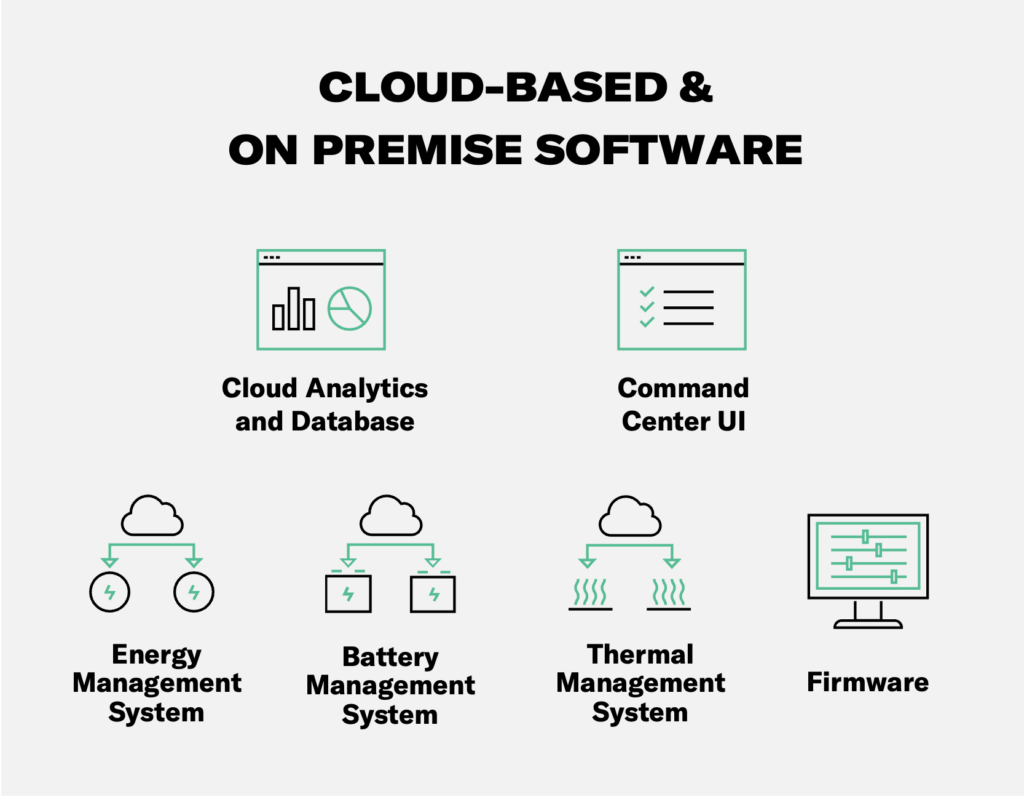Delivering Unmatched Safety, Availability, Insight, and Flexibility to Our Customers
By: Norman Farquhar, Head of Software Product Management at Powin and Monique Wong, Senior Software Product Manager at Powin
What is StackOS?
StackOS Software is the brain and nervous system of Powin’s battery energy storage systems (BESS). Integrated into all our hardware platforms, including the Centipede and Powin Pod, StackOS operates seamlessly both on-premise and in the cloud for every Powin site, transforming hundreds of thousands of battery cells into a single cohesive BESS.

The Uniqueness of StackOS
StackOS is a fully US-designed and built software system. From on-site firmware, Battery Management Systems (BMS), and Energy Management Systems (EMS) to cloud services—including our User Interface (UI), BESS data storage, and analytics—every component is designed to work together seamlessly. This holistic approach allows Powin to coordinate design and development across devices and functionalities to deliver unmatched safety and availability. There is never a gap in on a Powin system, as safety actions are coordinated from the cell to the Power Conversion System (PCS). Unlike an EMS-driven approach, our system-driven methodology offers unparalleled performance and reliability.
How Others Do It: Understanding the EMS-Driven Approach
The predominant alternative to Powin’s system-driven methodology in the market is an EMS-driven approach where integrators or EPCs procure a DC block with pre-packaged battery cells, hardware, firmware, and BMS. In this case, an integrator-provided or third-party EMS is combined with the cell provider firmware and BMS, treating the BMS as a black box.
Drawbacks of the EMS-Driven Approach
- The EMS-driven approach is limited by the data that is shared by the BMS from the battery cell provider. Thus, granular cell-level data needed for advanced control and optimization are not available.
- The EMS-driven approach also must abstract the control and SOC/SOH algorithms in the firmware and BMS—that is, the EMS treats the DC block as a “black box” where contactor management, balancing, derating, and E-stopping are handled “behind the scenes.” Simplifying these functions as a set of black box algorithms makes the EMS-driven approach prone to integration issues, delaying project execution timelines during the BESS commissioning phase.
- Determining the root cause of performance issues also becomes challenging with this approach because it is unclear whether the source of a problem is from the BMS or EMS.
How We Do It: Powin’s System-Driven Approach
Powin’s holistic system-driven approach is unique. We source hardware components—including battery cells from various vendors—to provide a stable supply chain and insulation against macroeconomic shocks to our customers. We develop firmware tailored to the specific sensors, balancing circuits, devices, and electrical architecture for each generation of Powin hardware, while maintaining a consistent, cohesive data reporting and Alarm/Warning/Error platform across generations. Most importantly, Powin fully develops and controls the interface between the firmware and BMS, as well as between the BMS and EMS. The firmware-BMS and BMS-EMS connections are foundational to every Powin BESS site.
Benefits of Powin’s System-Driven Approach
- In-house firmware, BMS, and EMS design and development enable us to collect, store, and analyze granular data down to the cell level. Cell-level data is strategically shared to each level of the system that requires granular insights and is integrated into real-time safety, derating, and balancing algorithms. Whereas a DC block in the EMS-driven approach might provide three voltage or temperature data points (min/average/max) for a string or array, a Powin site is surfacing and organizing hundreds or thousands of data points for the same string or array, driving enhanced safety and availability for the overall site.
- Cell-level data and control over firmware development provide real-time safety notifications and allow Powin to equip BESS operators with precise data to make the best real-time operating decisions.
- Specific, tight, in-house developed Application Programming Interfaces (APIs) between devices and layers of the system reduce integration issues. Powin Engineering teams are in constant communication while developing features, test procedures, and bug fixes with every piece of the system in mind. This approach reduces integration issues, de-risking project schedules and driving higher confidence in on-time delivery compared to the EMS-driven approach.
- Our system-driven methodology ensures consistency and reliability across projects, eliminating the need to switch software foundations for each new project or cell.
Why Powin’s Approach Matters
Our system-driven approach empowers us to build intelligent systems using high-quality battery module and cell-level data. With comprehensive data collected from our sensors, we can refine what’s reported to the EMS and what is relevant to be surfaced to the cloud for advanced analytics. Powin’s approach offers better visibility into the BESS system, enabling us to build better control algorithms and provide system operators with deeper insights. With StackOS Software and our system-driven approach, Powin delivers safety, availability, insight, and flexibility to our customers. Let’s dive deeper into each of these benefits.
StackOS Benefit #1: Ensuring System & Operational Safety
Safety is paramount for Powin. Our vertical integration, starting with our firmware, differentiates our ability to deliver safe energy storage systems because it enables our system to “work as one” to comply with the highest safety standards.
- By building our own firmware, we can certify and ensure that each string is safe and protected on its own, on a timescale of milliseconds.
- By building our own BMS to be integrated and work with our firmware, we ensure BESS operations are smooth, avoiding disjointed commands.
- By integrating Powin’s proprietary EMS with our BMS, we ensure coordinated operations, avoiding the risks associated with inconsistent control signals.
- By providing the cloud-based Powin Command Center, we give operators unprecedented visibility to monitor system safety. Our advanced analytics team uses granular cell-level data to build algorithms that flag faulty devices and weak cells early for remediation to enhance safety. Our integrated system approach means we deliver a safer system that improves over time.
StackOS ensures safe operation and servicing of Powin systems. Our control algorithms automatically take preemptive actions to preserve equipment and shut systems down before unsafe situations arise. During field service, the software protects personnel with automatic safety measures, such as emergency stops for open doors, ensuring safety of personnel.
StackOS Benefit #2: Maximizing Availability
StackOS plays a crucial role in maintaining high power and energy availability. While controlling and monitoring the largest database of operational battery cell data in the US, we are constantly innovating to ensure industry-leading DC availability.
StackOS has automated functions built in that, at its core, maintain high availability. Examples include HVAC control, fan balancing, and automatic cell balancing. Manual controls are also made available to allow experts to configure systems and/or respond to specific situations to improve availability.
Using millions of cell-level data points, Powin has built an advanced State of Charge (SOC) estimation algorithm that will be released for all sites in 2024. SOC estimation is a uniquely challenging problem for lithium iron phosphate (LFP) cells, yet Powin’s algorithm has consistently achieved accuracy within ~3% at the string level over millions of hours of beta testing. Powin provides availability that customers can trust to support high-stakes bidding and operations in fast-changing, dynamic markets across the globe.
Powin is also building additional intelligence that taps into years of BESS operational experience and terabytes of operational data for each site to implement advanced anomaly detection and predictive maintenance services. The goal is to improve availability and prevent minor issues from escalating to availability-disrupting events. When customers purchase a Powin BESS, they receive a constantly updated, tightly integrated software system that maximizes energy and power availability to help owners meet their revenue goals.
StackOS Benefit #3: Providing Insight
Powin systems offer unmatched observability into real-time system states. Critical information is surfaced to guide BESS operator attention, while allowing deep dives into cell-level data for troubleshooting and understanding what’s happening in each enclosure, string, pack, and cell. Our cloud and on-premises software work together to filter signals from hundreds of thousands or millions of sensors into the most important actionable insights to maintain safety and improve availability. StackOS combines unprecedented real-time insight and expert analytics to help owners better operate their system now and over time.
StackOS Benefit #4: Ensuring Flexibility
Designed for versatility, Powin systems integrate with multiple cell vendors, Power Conversion Systems (PCSs), and—on our roadmap—with multiple Power Plant Controllers (PPCs). Our systems automatically change BMS and EMS operations to adapt to different cell types and characteristics, which are established by our experts at the Powin Battery Lab. Our system adaptability covers every major use case for North American Independent System Operators (ISOs) and some international grids. Our new software architecture integrates with the eks Energy PPC and will be integrated with other PPCs in the future, facilitating easier and faster interconnections in the toughest markets. This makes Powin software the central building block that connects different cells to different grids with as little friction as possible.
Conclusion
StackOS is at the core of Powin’s innovative energy storage solutions, delivering unmatched safety, availability, insight, and flexibility. Our unique system-driven approach, vertical system integration, and advanced analytics set us apart and ensure our systems are continuously improving to meet our customers’ evolving needs. Powin is proud to be playing an integral role in the transition to a clean energy future with StackOS Software.
For the latest updates and news please visit our website or connect with us on LinkedIn.

